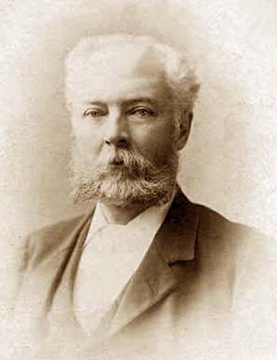|
Nottingham Buildings Watson
Fothergill |
|||||
| - | |||||
 * *
|
|||||
| - | |||||
| Watson Fothergill 1841 - 1928 | |||||
|
Nottingham is fortunate to have numerous buildings of quality and style designed by many talented architects over the past three hundred years. Sadly, little remains of our heritage pre-1700 save for two beautiful churches, but with the coming of the industrial revolution and the railways, the wealth that these generated heralded an explosion of building activity, particularly during the Victorian era. During this period, two architects were pre-eminent in the city for the volume of work they achieved and the buildings that they designed still stand out in the built environment to this very day and enhance our lives as we walk past and admire them. They were Thomas Chambers Hine and Watson Fothergill. Of the two, my favourite is Watson Fothergill who's designs were far more flamboyant than the reserved style of Hine. I doubt if Fothergill could design a basic box warehouse structure even if his life depended upon it, and he made utilitarian structures like that stand out from the ordinary with the addition of subtle embellishments and quirky additions. These embellishments were not always costly and on several designs he demonstrated that a building could be given style and individuality with the use of just different brick types and two or three non-standard brick shapes laid in several different ways and configurations. In my view the magnificent Black Boy Hotel on Long Row was his masterpiece but sadly that was lost to 'progress' and demolished in the 1960's. Two of my own favourite Fothergill buildings that still survive are firstly Queens Chambers on the corner of Long Row and Queen Street. What a glorious mix if styles it is and on a sunny day, there is nothing to compare with it. Fothergill really pulled out all the stops on that one but I suspect that this and some others would not score too highly if marked on internal practicality and functionality of use. The other is The Nottingham and Nott's Bank on Thurland street a truly grand building and very different to Queens Chambers but still with very many fine details including a row of beautiful stained glass windows. Most if not all of the inner city
Fothergill buildings are represented on this website and are denoted in
the buildings index with the mark ' Watson Fothergill was born just a few miles from Nottingham in the market town of Mansfield. He was born, Fothergill Watson, but later changed his name to Watson Fothergill so as to preserve his mothers maiden name. Fothergill left school in 1856 and started work as a trainee with family friend Frederick Jackson who ran a firm of engineers, architects and surveyors in Nottingham. After four years he went to work for Nottingham architect I. C. Gilbert and then moved to London where he studied and worked part time in the offices of Arthur Bloomfield. He returned to Nottingham in 1864 to set up his own office in Clinton Street where he remained until 1893 when the coming of the Great Central Railway necessitated its demolition. With the money gained in compensation he then built the very ornate offices on George Street that still survive. Fothergill designs fall broadly under the umbrella of The Gothic Revival Style but have a strong influence from Old English, Tudor and even Scottish Baronial styles all of which are blended together in the Fothergill way to produce a unique 'Fothergill' style that is very distinctive and readily recognizable in the city. Fothergill's style was also noticeably influenced by other architects such as Augustus Welby Northmore Pugin (Who designed The Palace of Westminster, London and St. Barnabas Cathedral in Derby Road), and George Edmond Street (Who designed The Royal Courts of Justice, London). These two 'heroes' of his are immortalized in stone on the frontage of his George Street office. Also an influence was George Gilbert Scott ( Who designed the Midland Grand Hotel at St. Pancras Station in London and, nearer to home, Kelham Hall near Newark).. Fothergill's first big break came in 1876 when he won a competition to design the Nottingham Albert Hall on North Circus Street and in that same year, the Express Offices on Upper Parliament Street. Unfortunately his Albert Hall was destroyed by fire in 1906 but the Express Offices still remain. Following these two commissions, his career flourished and he went on to design many more buildings in the city from banks, offices, warehouses, factories, churches and public houses to private residences. I think it also fair to assume that he was also influenced (Maybe always not willingly), by his competitor Thomas Chambers Hine. Hine had been given the job of overseeing the development of the Park Estate by the Duke of Newcastle and Fothergill had to submit all his plans for residences in the park for his approval before they could be built. Fothergill also undertook a number of commissions outside the city. Watson Fothergill died in 1928 and was laid to rest in the Church or Rock Cemetery on Mansfield Road / Forest Road. The city would certainly be a much duller place without the wonderful flamboyant designs that Fothergill left us. For greater detail of is life - visit the Watson Fothergill website. Ken Brand of The Nottingham Civic Society has written a book on Fothergill - See this link to the Civic Society page. |
|||||
| *
The
image of Watson Fothergill was taken from an internet search for
'copyright free images' and I use it here in that belief. Should this not be true, please inform me and I shall immediately take it down |
|||||
| a | |||||
|
|||||